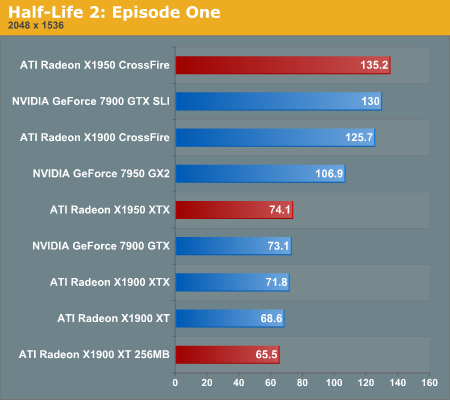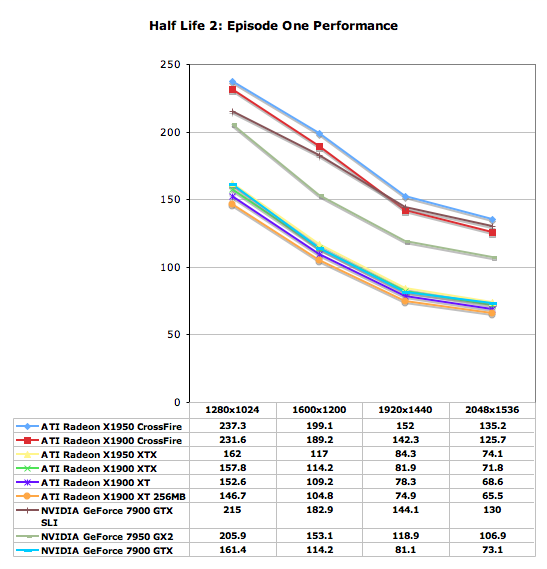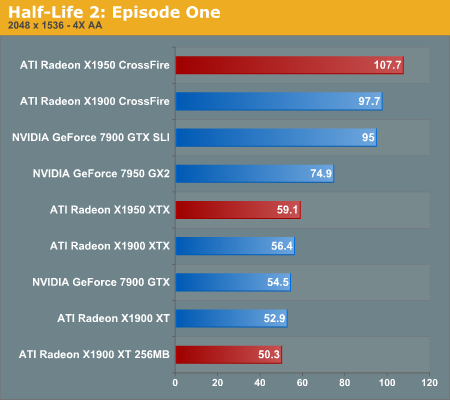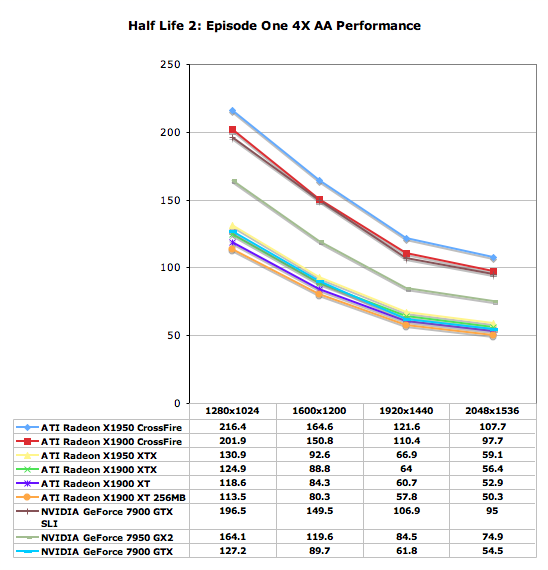ATI's New High End and Mid Range: Radeon X1950 XTX & X1900 XT 256MB
by Derek Wilson on August 23, 2006 9:52 AM EST- Posted in
- GPUs
Half-Life 2: Episode One Performance
Episode One of the new Half-Life 2 series makes use of recent Source engine updates to include Valve's HDR technology. While some people have done HDR that won't allow antialiasing (even on ATI cards), Valve put a high value on building an HDR implementation that everyone can use with whatever settings they want. Consistency of experience is usually not important enough to developers who care about pushing the bleeding edge of technology, so we are very happy to see Valve going down this path.
We use the built-in timedemo feature to benchmark the game. Our timedemo consists of a protracted rocket launcher fight and features much debris and pyrotechnics. The source engine timedemo feature is more like the nettimedemo of Id's Doom 3 engine, in that it plays back more than just the graphics. In fact, Valve includes some fairly intensive diagnostic tools that will reveal almost everything about every object in a scene. We haven't found a good use for this in the context of reviewing computer hardware, but our options are always open.
The highest visual quality settings possible were used including the "reflect all" setting which is normally not enabled by default. Antialiasing was left disabled for this test, and anisotropic filtering was set at 8x. While the Source engine is notorious for giving great framerates for almost any hardware setup, we find the game isn't as enjoyable if it isn't running at at least 30fps. This is very attainable even at the highest resolution we tested on most cards, and thus our target framerate is a little higher in this game than others.


Most of the solutions scale the same in Half-Life 2: Episode 1, with the possible exception of the 7900 GTX SLI setup hitting a bit of an NVIDIA driver inspired CPU limitation at 1280x1024. We can't really complain, as scoring over 200 fps is really an accomplishment in itself. With scores like these across the board, there's no reason not to run with AA enabled.


With even the slowest tested solution offering over 50 FPS at 2048x1536 4xAA, gamers playing HL2 variants can run with any of the high-end GPU solutions without problem. ATI does manage to claim a ~10% performance victory with the X1950 CrossFire over the 7900 GTX SLI, so if the pattern holds in future episodes ATI will be a slightly faster solution. The X1900 CrossFire configuration was also slightly faster than the SLI setup, though for all practical purposes that matchup is a tie.










74 Comments
View All Comments
TigerFlash - Wednesday, August 23, 2006 - link
I suppose I worded that the opposite way. Do you think Intel will stop supporting Crossfire cards?michal1980 - Wednesday, August 23, 2006 - link
Can we not even get any numbers for cards below the 7900GTX.I understand your limited, but how about some numbers from some cards below that, to see what an upgrade would do.
I know we can kind of take test from old reviews of the cards, but your test bed has changed since core 2, so its not a fair heads to heads test of old numbers to new.
it would be nice to see if theres a point(wise or not) to upgrade from a 7800gt or that gen of cards, or something slower like a 7900gt.
but it seems like ever 'new gen' card test just drops off 'older' cards
michal1980 - Wednesday, August 23, 2006 - link
what i meant is that on the tables, or where all the new cards are, it would be nice to have some numbers for old cards.Lifted - Wednesday, August 23, 2006 - link
Agreed. I'm still running a 6800GT and have not seen much of a reason to upgrade with the current software I run. Perhaps if I saw that newer games are 3x faster I might consider an upgrade, so how about it?